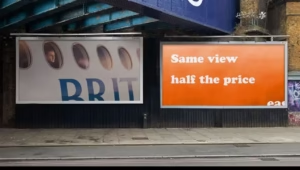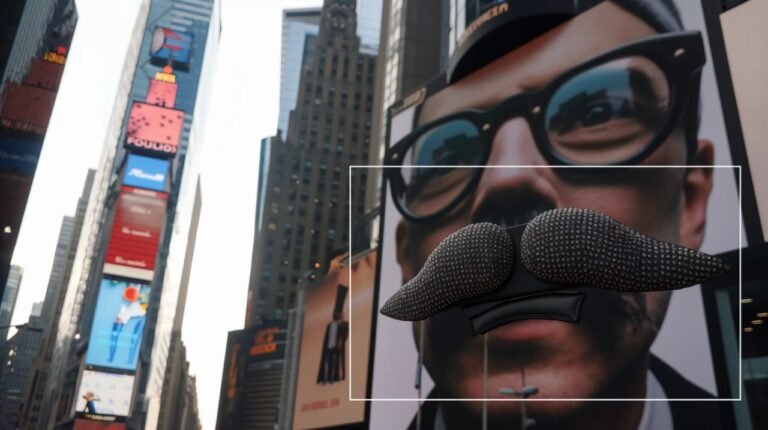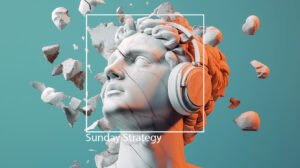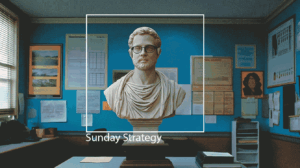BMW and Audi dealership advertising wars. Easyjet Responses to British Airways Billboards. Makeup products colliding with buses. The internet is awash with examples of brands making witty advertising and surprising executions, only to reveal – on closer inspection or with additional discussion — that they’re fake.

From fake print ads, to OOH and brand social content, fake ads have become a quick fix for many brands to capture attention at a scale beyond logistics, budgets or appetites. Though while there are clear upsides to running mockups or fake stunts as the real thing, there are issues to consider.
The biggest issue being that fake advertising asks a question, but it doesn’t work hard enough to answer it. It tells a story, when it could make an outcome. Ad students and customers get to ask ‘what if’ in isolation, but agencies and brands have enough scale and resources to make it real if it matters. The trade press that celebrates a fake ad ignores a long term cost to what makes advertising unique.
Fake ads, like many of the faux OOH ads from the last year, are flourishing in a specific moment – with generative AI poised to give anyone the ability to create them and make them more believable. While this technology may seem like it will create a golden age for the fake ad, in reality it will raise the bar on what people will pay attention to.
“Is that real?” is a hard but achievable outcome today through craft and CGI. However, tomorrow, either extreme creativity or tangibility will be required to garner the same attention. From RunwayML to Unreal Engine, photorealism and fakery is democratising. When anyone can make it look like a mascara brush just hit a London tube train, tomorrow’s most unique way for a brand to stand out comes back to making it real. When everyone can create fake content, real follow through in building something is powerful. Following through isn’t just about believability though, it’s an organisational muscle. It makes ‘what If’ become a tool for growth, because it helps us also ask ‘why not?’.
Possibility and potential have a unique place in successful advertising and media agencies. However, the advertising industry doesn’t have a patent on them. Instead, as more people become creators, agencies have to fall back on potential’s business partner, tangibility. Advertisers and brands don’t just dream up new things and possibilities, we produce and deliver them. We don’t just concept, we strategize on what ideas can deliver in business terms, fund them through agreement and discussion, plan and produce them into the world. It might be unclear if the Inuit really have 50 words for snow, but advertisers should have as many for potential – with one of those reserved for when it is made real.
Complaints about fake advertising often spark cynicism about logistical or client concerns. “My brand would never really sign that off” or “I could never get budget for that” speak to the constraints potential faces everyday. Mockups and fakes allow us to side step these, but at the cost of greater inspiration. They encourage settling in the face of constraint instead of innovating. Making a piece of content instead of an idea that is strong enough to be real or evolve. They keep us from asking the equally important question “Why not?” when faced with a challenge.
There is a time and place for mockups, fun and fakes. However, taking ‘what if’ seriously can lead to something more than a one off. In overcoming constraints to big ideas, we can discover new insights, processes or products. We experiment as we struggle. We can make ideas that become experiences across media. We can train ourselves to break down the big eye-catching impossibilities to small realities.
We can commit to a fleeting joke or potential idea to make it even stronger. In the crop of this year’s April Fools brand activations, Duolingo’s fake ‘Duo on Ice’ musical stood out, not just because of its humor, but because they went as far as partnering with Seat Geek to sell fake tickets. Pushing fake towards real makes things richer.
Instead of mocking up a fake ad for social media, it’s worth asking why it couldn’t be real? Diving into constraints and adjusting makes creativity stronger. If it is impossible now, what needs to change to make it possible? If a big idea can’t work, what little ideas get us there?
We can start with ‘what if’, but great ideas deserve agencies to continue to ‘why not’.



